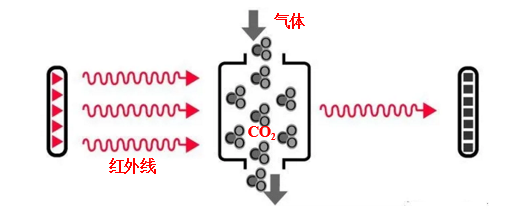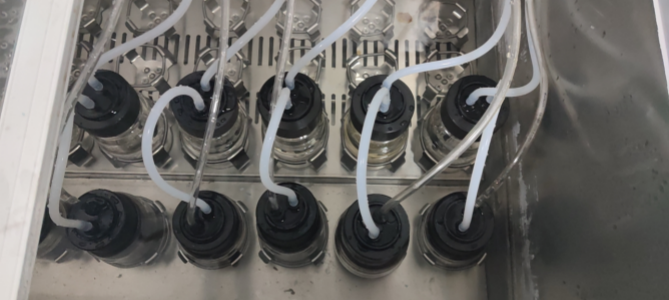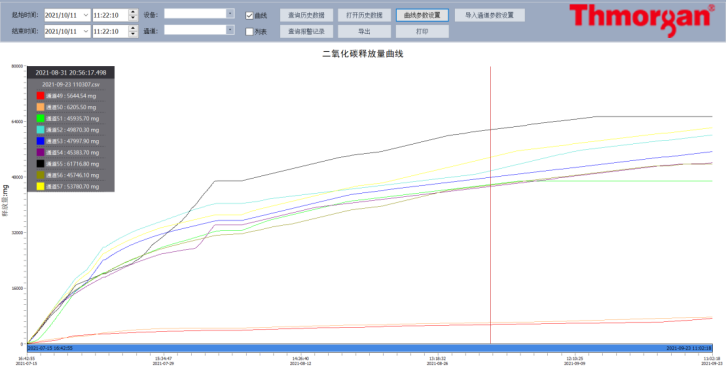Product
All categories

Hydroponic infrared biodegradation instrument
Model :T1200
Product use
1. Meet the test standards of GB/T19276.2-2003;
2. Meet the test standards of GB/T33616-2017;
3. Meet the test requirements of GB/T40612-2021;
4. Meet the test requirements of GB/T40367-2021;
5. Meet the ISO14852-1999 testing standards;
6. Meet the testing standards of ISO19679-2020;
7. Can be used for activated sludge biodegradation detection;
8. Can be used for bio-based biodegradability detection;
Product features
1. With temperament combined system;
2. Fully meet the test requirements of GB/T 19276.2 standard;
3. The design method of water-based culture and open oxygen supply is adopted to simulate the strong aerobic environment;
4. 12 independent infrared detection, real-time online measurement of carbon dioxide release;
5. Wide detection range, the maximum detection limit can reach 5000ppm;
6. Dual display of carbon dioxide concentration and accumulation, which can be derived in the form of charts or curves;
7. Air bath temperature control, temperature adjustment accuracy ±0.1℃;
8. Magnetic mixing system: provide long time mixing;
9. Cloud platform detection, real-time online observation of data and curves;
Product principle
This experiment system simulates the process of biodegradation of bio-based materials under aerobic hydroponics. In the aerobic hydroponic environment, microorganisms consume oxygen and produce carbon dioxide, water and other inorganic substances. The generated carbon dioxide is monitored in real time by high-precision infrared sensor, and the real-time concentration of detected carbon dioxide is integrated with the flow rate and time, so as to calculate the carbon dioxide release from the biodegradation of the sample. The biodegradation rate is the percentage of the carbon dioxide released by the sample biodegradation and its theoretical carbon dioxide release.

Product parameters
1. Working conditions:
1.1 Power supply voltage: AC 220V±10% 50Hz single-phase;
1.2 Working temperature: 15 ~ 30℃;
1.3 Relative humidity: ≤ 80%;
1.4 Power: 4KW;
1.5 Appearance size (L×W×H):2000mm×900mm×1600mm;
1.6 Gross weight :180KG;
2. Oxygen supply system:
2.1 Air supply mode: continuous aeration oxygen supply, built-in air supply pump;
2.2 Air pump control: the air pump is divided into 12 channels, each channel has an independent switch;
2.3 Flow control mode: PLC control, flow can be automatically adjusted according to the set value;
2.4 Flow control accuracy: ±1%;
2.5 Flow collection method: electronic flowmeter real-time collection;
2.6 Flow collection range: 0.01-500ml /min;
2.7 With 12 electronic flowmeters to collect flow;
2.8 Flow control and flow collection operate independently;

3. Temperature control system:
3.1 Temperature control mode: air bath;
3.2 Set temperature range: room temperature -90 ℃, step by 0.1℃;
3.3 Temperature control accuracy: ≤±0.1℃;
3.4 The temperature control box is divided into two layers, the front door is open;
4. Reaction system:
4.1 Number of channels: ≥12;
4.2 Mixing method: 12 channels magnetic mixing;
4.3 Reaction mode: liquid reaction;
4.4 Volume of reaction bottle: 500ml;
4.5 Decarbonization system: Yes;
4.6 Condensing system: Yes;
5. Detection system:
5.1 Detection method: infrared carbon dioxide detection;
5.2 Number of infrared probes: ≥12
5.3 Display mode: synchronous dual display of carbon dioxide concentration and total amount;
5.4 Detection range: 0-5000ppm;
5.5 Resolution: 1ppm;
5.6 Data collection cycle: up to 1 second once, seconds, minutes, hours can be freely selected;
6. Software control system:
6.1 Software control system with independent intellectual property rights;
6.2 Software can collect data and generate real-time data curve;
6.3 Bearer system: professional operating system such as win7/8/10;
6.4 Data storage: It can be stored in real time in the experiment;
6.5 With a cloud platform, data can be accessed remotely;
6.6 USB ports: 3;

7. Combined temperament system:
7.1 The combined system is divided into three parts: intake unit, steady flow unit and supply unit;
7.2 Air intake unit: 24 channels, each channel has an independent electromagnetic reversing valve;
7.3 Intake unit: Each channel can be independently controlled, with intake, emptying, supply three-way design;
7.4 Steady flow unit: single-channel design, providing an independent channel for the reaction gas of the target channel;
7.5 Air intake unit: provide independent and pollution-free target gas for gas phase and temperament;
7.6 The system can be integrated with the biodegrader and does not occupy other operating space;
7.7 The system can also be used independently.
Standard configuration
|
Serial number |
name |
quantity |
unit |
remark |
|
1 |
host |
1 |
Taiwan |
|
|
2 |
Reaction flask |
12 |
entries |
|
|
3 |
Decarburization bottle |
12 |
entries |
|
|
4 |
Condensing bottle |
12 |
entries |
|
|
5 |
Dehumidifier bottle |
12 |
entries |
|
|
6 |
Connecting hose |
1 |
Set of |
|
|
7 |
software |
1 |
Set of |
|
|
8 |
Rando |
1 |
Set of |
|
Examples of experiments
This is the experimental result of determining the biodegradability of a sample by using T1200C hydroponic biodegradation instrument and referring to the method standard of GB/T19276.2-2003. The test period is 49 days. At the end of the test, the average degradation rate of cellulose is 89.41%, and the curve of various product groups is flat, and the growth is basically over. The experimental design and experimental results are as follows:
Table 1 Experimental design
|
|
1 |
2 |
3 |
4 |
5 |
6 |
7 |
8 |
9 |
|
Inoculum |
300ml |
300ml |
300ml |
300ml |
300ml |
300ml |
300ml |
300ml |
300ml |
|
Cellulose |
|
|
|
2.0g |
2.0g |
|
|
|
|
|
A4 paper |
|
|
|
|
|
2.0g |
2.0g |
|
|
|
Sample 1 |
|
|
|
|
|
|
|
2.0g |
2.0g |

Figure 1 CO2 emission curve




